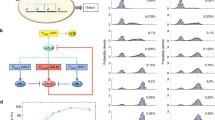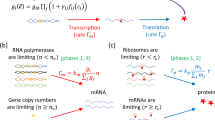Abstract.
The functioning of a living cell is largely determined by the structure of its regulatory network, comprising non-linear interactions between regulatory genes. An important factor for the stability and evolvability of such regulatory systems is neutrality – typically a large number of alternative network structures give rise to the necessary dynamics. Here we study the discretized regulatory dynamics of the yeast cell cycle [Li et al., PNAS, 2004] and the set of networks capable of reproducing it, which we call functional. Among these, the empirical yeast wildtype network is close to optimal with respect to sparse wiring. Under point mutations, which establish or delete single interactions, the neutral space of functional networks is fragmented into ≈ 4.7 × 108 components. One of the smaller ones contains the wildtype network. On average, functional networks reachable from the wildtype by mutations are sparser, have higher noise resilience and fewer fixed point attractors as compared with networks outside of this wildtype component.
Similar content being viewed by others
References
M. Kimura, The Neutral Theory of Molecular Evolution (Cambridge University Press, Cambridge, UK, 1983)
A. Wagner, Robustness and Evolvability in Living Systems (Princeton University Press, 2005)
P. Schuster, W. Fontana, P.F. Stadler, I.L. Hofacker, Proc. Roy. Soc. Lond. B 255, 279 (1994)
A. Babajide, I.L. Hofacker, M.J. Sippl, P.F. Stadler, Fold Des. 2, 261 (1997)
E. Davidson, M. Levin, Proceedings of the National Academy of Sciences of the United States of America 102, 4935 (2005)
S. Bornholdt, K. Sneppen, Phys. Rev. Lett. 81, 236 (1998)
S. Ciliberti, O.C. Martin, A. Wagner, Proceedings of the National Academy of Sciences of the United States of America 104, 13591 (2007)
S. Ciliberti, O.C. Martin, A. Wagner, PLoS Computational Biology 3, e15 (2007)
F. Stauffer, J. Berg, EPL 88, 48004 (2009)
F. Li, T. Long, Y. Lu, Q. Ouyang, C. Tang, Proceedings of the National Academy of Sciences of the United States of America 101, 4781 (2004)
P.T. Spellman, G. Sherlock, M.Q. Zhang, V.R. Iyer, K. Anders, M.B. Eisen, P.O. Brown, D. Botstein, B. Futcher, Mol. Biol. Cell. 9, 3273 (1998)
S. Kauffman, J. Theor. Biol. 22, 437 (1969)
B. Drossel, Reviews of Nonlinear Dynamics and Complexity (Wiley-VCH, 2008), Chap. Random Boolean Networks, Vol. 1, pp. 69–99
K.Y. Lau, S. Ganguli, C. Tang, Phys. Rev. E 75, 051907 (2007)
W. Imrich, Product Graphs: Structure And Recognition (Wiley Interscience Series in Discrete Mathematics, 2000)
Author information
Authors and Affiliations
Corresponding authors
Rights and permissions
About this article
Cite this article
Boldhaus, G., Klemm, K. Regulatory networks and connected components of the neutral space. Eur. Phys. J. B 77, 233–237 (2010). https://doi.org/10.1140/epjb/e2010-00176-4
Received:
Revised:
Published:
Issue Date:
DOI: https://doi.org/10.1140/epjb/e2010-00176-4




